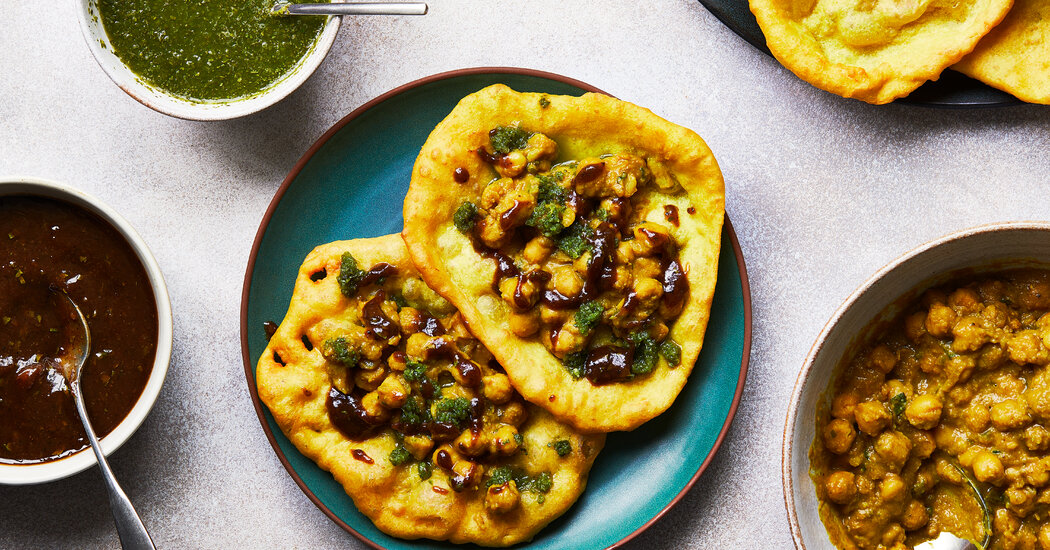There’s something distinctly satisfying about messy food: sauce dripping down the side of your mouth, juices drizzling across your fingers. It’s the experience you might have when eating a taco or a burger. And it’s most definitely the experience of eating doubles.
A popular street food from Trinidad and Tobago, doubles are made up of three elements: cumin and turmeric-laced bara (fried bread); flavorful channa (spelled with two n’s in Trinidad), or chickpeas; and spicy-sweet, tangy sauces and chutneys.
For Natasha Laggan, a cook and influencer who grew up in Trinidad and Tobago, doubles, sold from a bike, were a childhood staple.
“My mum and I would hear the bell, and we would just run out and stop him,” she said, of the man who would come through their neighborhood in Couva.
“I remember I was under 10 years old, and I just loved every evening to get doubles from him,” Ms. Laggan said.
Today, you’re more likely to get your doubles from a shop or stand than a bike, and you’ll find them in neighborhoods large and small. But this beloved dish serves as a reminder to the past, beyond nostalgia.
“I call it resistance food,” said Badru Deen, whose parents are credited with inventing doubles. The son of indentured laborers on the island, Mr. Deen’s father, Emamool, and his wife, Raheman Rasulan, experienced substantial poverty, the result of 160 years of British colonization. “My parents were resisting a terrible colonial system, a plantation system that enslaved them basically,” he said.
In the 1930s, looking to make extra money for his growing family — Badru Deen is the seventh of nine children — Emamool Deen sold the family goat to buy bulk oil and dried channa, affordable ingredients readily available to them. First, he made and sold fried channa and later saucy channa on bara. Eventually, people started requesting two baras with their saucy channa ahead of busy workdays, and doubles were born.
Mr. Deen would sell them directly from his bicycle — ringing his bell, riding up and down hilly Trinidadian streets. Nothing was wasted: Oil cans were used to transport, even cook the channa, and leftovers fed the family.
“Doubles were an extremely cheap food, made to sell on the street to try and earn some cash and get ahead,” said Ramin Ganeshram, a culinary historian who has contributed to The New York Times and the author of “Sweet Hands: Island Cooking from Trinidad & Tobago.” “In other words, they were creating something out of nothing.”
The dish is loved beyond the boundaries of the small island nation and its diaspora, with population centers in New York, Florida, Canada and Britain.
Kwame Onwuachi, the chef of Tatiana in New York, grew up in the Bronx eating both Nigerian and Trinidadian foods. But, like many in the diaspora, he didn’t experience traditional dishes like doubles until he visited the island as an adult, with his Trinidadian grandfather.
The crisp of the bara, the flavorful channa, punctuated by tart tamarind and fiery pepper sauce, Mr. Onwuachi describes it as a beautiful “symphony of flavors and textures.”
Sometimes dishes from blended cultures, like that of Trinidad, a mix of Indigenous, African, Indian and British influences, reflect varied roots. Think of Puerto Rican mofongo, which combines African, Indigenous and Spanish techniques and flavors. But doubles’s Caribbeanness is subtle, most notable in the use of native Scotch bonnet peppers and chadon beni or culantro. It’s the Indian flavors — cumin and coriander, turmeric and tamarind — that rise to the top.
Krishnendu Ray, who directs the food studies doctoral program at New York University, said doubles synthesize the many cultures of Trinidad and the diaspora itself.
“When cultures meet, a new culture is brought into being,” he says. “That’s the doubling.”







